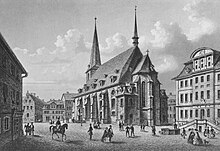Der Himmel lacht! Die Erde jubilieret, BWV 31
| Der Himmel lacht! Die Erde jubilieret | |
|---|---|
| BWV 31 | |
| Church cantata by J. S. Bach | |

St. Peter und Paul, Weimar, probably the location of the first performance
|
|
| Occasion | First Day of Easter |
| Performed | 21 April 1715: Weimar |
| Movements | 9 |
| Cantata text | Salomon Franck |
| Chorale | by Nikolaus Herman |
| Vocal | |
| Instrumental |
|
Der Himmel lacht! Die Erde jubilieret (Heaven laughs! Earth exults),BWV 31, is a cantata by Johann Sebastian Bach, a church cantata for the first day of Easter. Bach composed the cantata in Weimar and first performed it on 21 April 1715.
On 2 March 1714 Bach was appointed concertmaster of the Weimar court capelle of the co-reigning dukes Wilhelm Ernst and Ernst August of Saxe-Weimar. As concertmaster, he assumed the principal responsibility for composing new works, specifically cantatas for the Schloßkirche (palace church), on a monthly schedule. Bach composed the cantata for Easter Sunday in 1715. The prescribed readings for the feast day were from the First letter to the Corinthians, "Christ is our Easter lamb" (), and from the Gospel of Mark, the Resurrection of Jesus (). The text was written by the Weimar poet Salomon Franck who published it in Evangelisches Andachts-Opffer (Evangelical Offering of Prayers). The verses consist purely of free poetry and interpret the Easter message, connected to the request to believers to let Jesus also be resurrected within their souls. The final movement, the last verse of the chorale "Wenn mein Stündlein vorhanden ist" (When my hour is come) by Nikolaus Herman, expresses the desire to die, to follow Jesus in resurrection.
Bach first performed the cantata on 21 April 1715. Looking at the rich scoring of three instrumental groups and a five-part choir, John Eliot Gardiner suggests that the cantata was not performed in the court's small Schloßkirche, but in the town church St. Peter und Paul, where the ducal family evidently at times attended services. Bach later performed the cantata several times in Leipzig in a slightly modified form. There is proof of performances for the years 1724 and 1731; a further performance in 1735 is probable as well. Since the Weimar tuning of the organ, which served as a reference for the string instruments, was probably a third higher than the standard tuning tone in Leipzig, Bach had to either leave out the voices of the reed instruments or rewrite them for the Leipzig performances, or to replace the parts by different instruments.
...
Wikipedia
